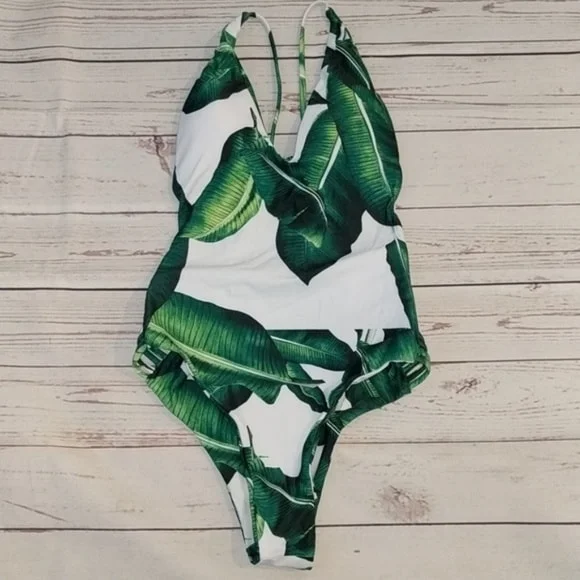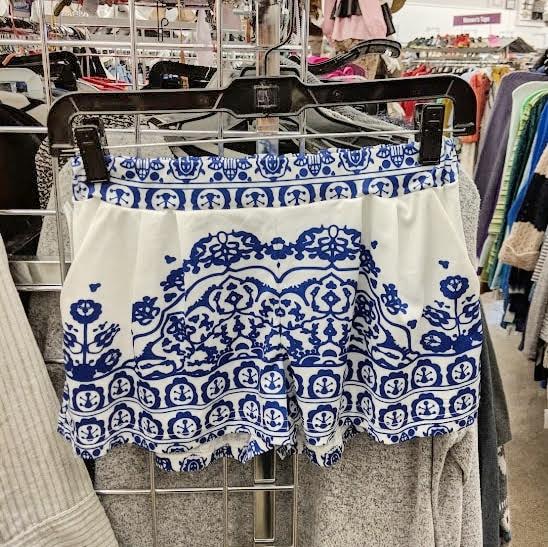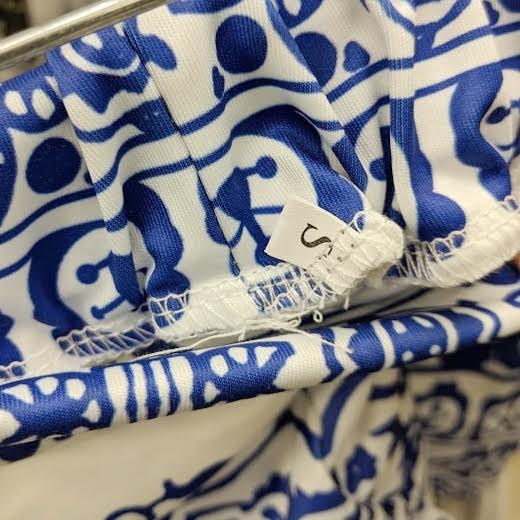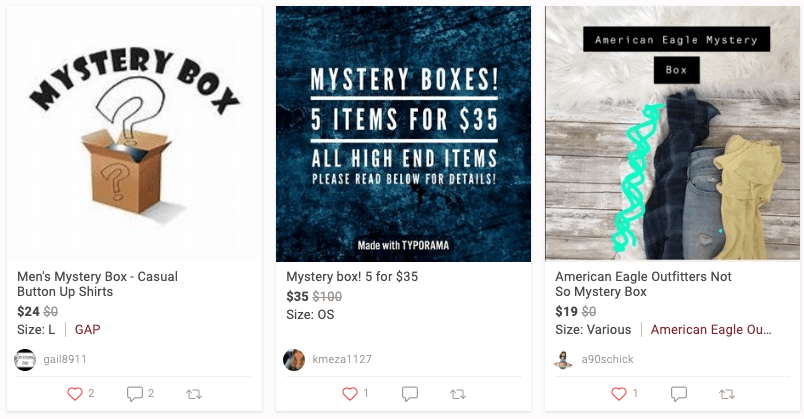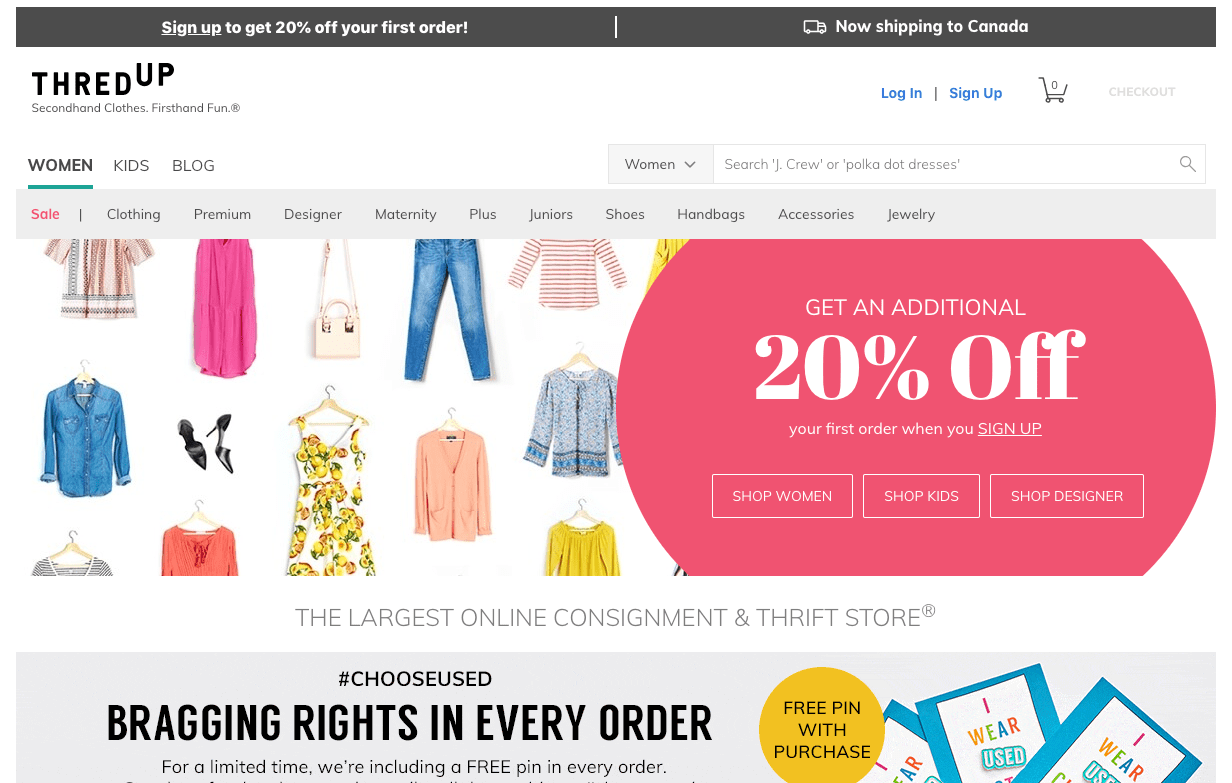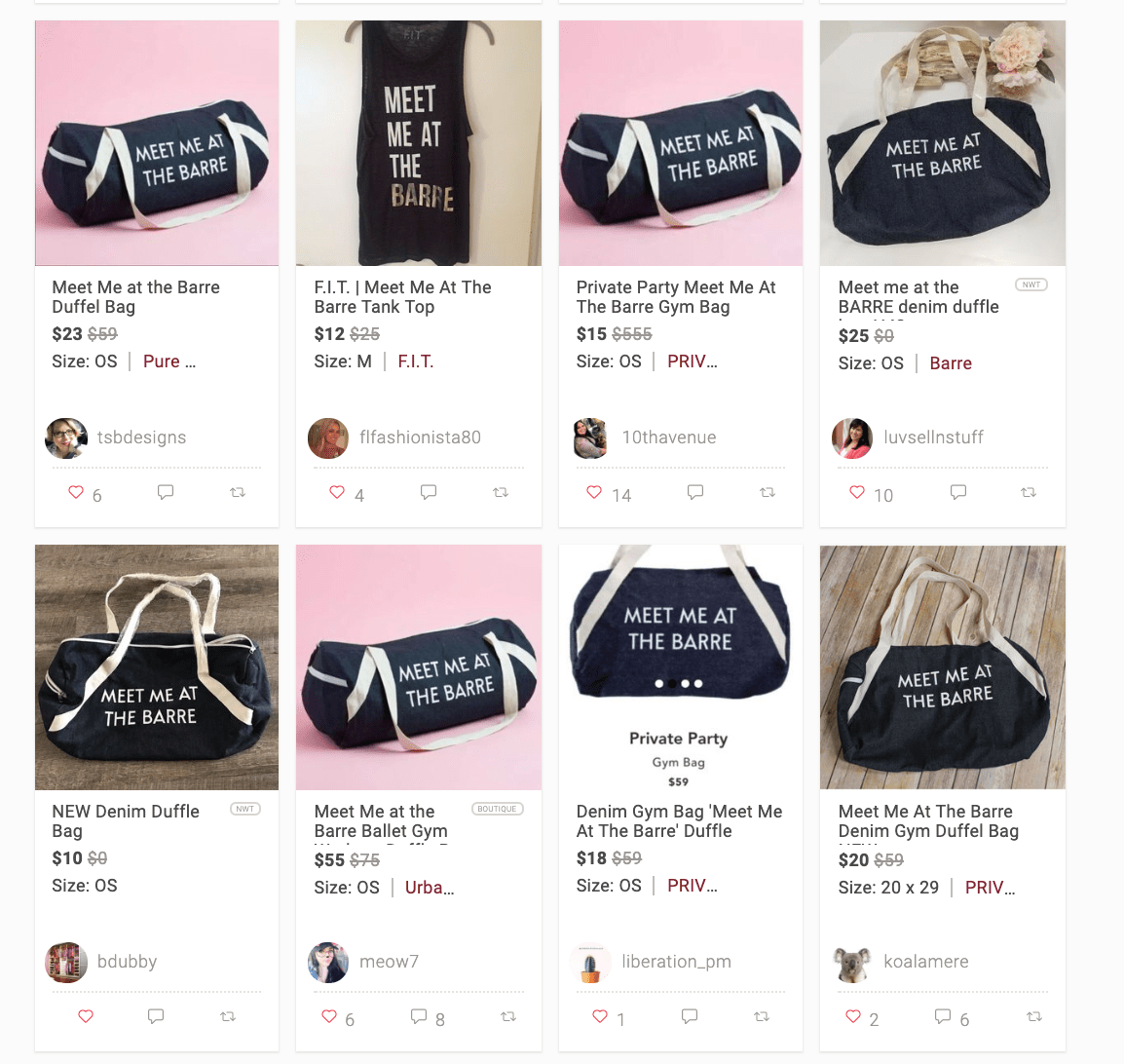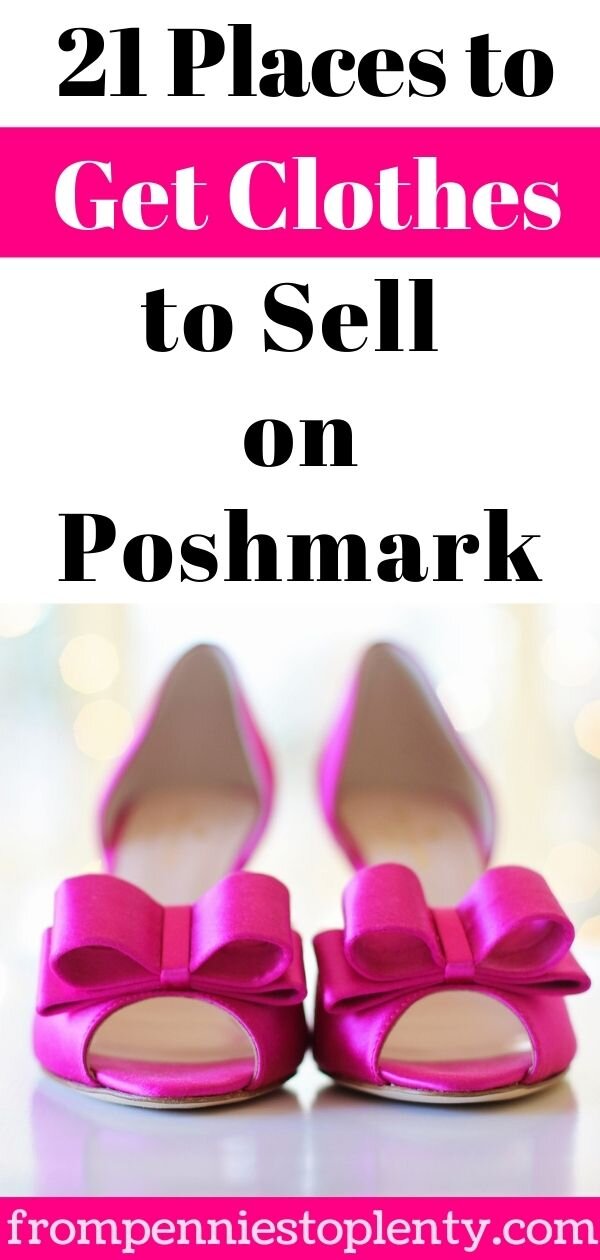26 Places to Get Clothes to Sell on Poshmark
Updated 2/16/23
Today I want to discuss many of the places where you can get clothes to sell on Poshmark. When I first started selling on Poshmark in 2015, I began by selling clothes from my own closet. I soon ran out of things to sell and turned to thrift stores to source more inventory.
It’s worked for me over the years because I resell in small quantities as a side hustle only. I realize that a lot of sellers have grander goals and therefore need more inventory. I recently received this question from a Poshmark seller:
“I’ve started to sell on Poshmark and want to see if I can generate at least $1000/mo to help with my son’s college expenses. One of my questions is how do I get more inventory?”
This is a good question because you need enough of the right inventory to hit your sales goals. Whether you’re a new seller or a seasoned one, it can be hard to find enough low-cost high-quality items to flip for a profit month after month and year after year.
Having alternative sources for obtaining inventory can make a huge difference to your profits.
Where can you get clothes to sell on Poshmark (or any other resale site)?
Note: This post focuses on sourcing items allowed on Poshmark: clothes, shoes, accessories, and similar items. This list is long but doesn't mention every source available. If you have other places to source items for reselling, I welcome your comments and input.
Disclosure: This post contains affiliate links. This means that I may receive compensation when you click on a product link or purchase an item linked on this site. Click here for details.
** If you don’t have a Poshmark account, you can receive a free $10 bonus when you sign up with my code SFGIRL2015.
** On Mercari, you can get $10 when you sign up with the code JENMHM. The amount may vary by promotion.
1 | Your own house and closet
The best place to start sourcing is your own house. I’ve read that most people wear only 20% of their wardrobe regularly. That’s a lot of unworn clothes in people’s closets! If that’s true for you, your closet is a great place to find items to sell.
The best part about selling your old clothes is that you can learn how Poshmark or another platform works without investing any money into inventory. You actually recoup money for items that you paid for but don’t wear.
Related post: How to Clear Out Your Closet Quickly Without Regret
2 | Thrift stores & outlets
Thrift stores are my favorite place to find items to resell. Prices tend to be low enough that you make a profit when you resell the right items. Goodwill in my area sells clothing for about $3.99 to $12.99. Some of it is worth purchasing for resale; some of it is not.
Being successful at thrift store shopping requires knowing what brands to look for.
I started by shopping for a few brands that I knew were in demand. I increased my brand awareness by looking up brands I came across as I shopped, browsing Poshmark to see what sold, and taking note of what women talked about and wore.
Goodwill outlets AKA "the bins" are an even cheaper alternative to thrift stores.
Items come out in giant bins that you have to sift through to find sellable clothes. People source clothes, shoes, toys, and household goods from the bins.
Clothing and other items sell by the pound for ridiculously low prices. The Goodwill outlet closest to me sells items for $1.79/lb and cheaper than that when you buy more than 20 lbs. I’ve purchased sweaters for approximately $0.50 and winter jackets for $1.50. Lower cost per item means higher profits when they sell.
You have to have tough skin to shop at the outlets. Some outlets are filled with buyers who are very competitive to get the best items. You have to willing to get dirty too because the bins can have dirty clothes and other unpleasant things.
Related post: How to Thrift Shop at Goodwill Outlets
3 | Curated second-hand shops
Curated second-hand shops exist in many cities and towns. You might be familiar with some like Crossroads, Buffalo Exchange, and Plato’s Closet. People bring their clothing to these stores to sell in exchange for cash or store credit.
Employees inspect each item and accept only the ones they think will sell. Because these stores curate what they sell and are for-profit, their prices are higher than you’d find at thrift stores.
I like these shops because the items are typically higher quality and in better condition than thrift store items. You’re likely to find more high-end brands, unique items, and even luxury goods.
The difficulty with this option is that you have to be more selective about what you buy to resell.
Many items sell for about the same as you’d find on Poshmark. There’s often no room to mark up the product and make a profit.
It pays to know what brands sell for a lot on Poshmark and look for those at these stores. Louis Vuitton, Lilly Pulitzer, and Lululemon are a few of the brands I’ve found at Crossroads and been able to flip for more on Poshmark.
I’ve also found it helpful to look at the half-off rack and half-off items scattered throughout the store. I’ve found some great half-priced items for myself and for resale. Some stores have periodic sidewalk sales where everything is discounted really cheap so they can clear extra inventory.
One thing I’ve noticed is that sometimes items don’t sell well locally due to regional differences but will sell well online because Poshmark is nationwide.
Heavy winter gear isn’t as common where I live in CA because the weather doesn’t get very cold. These items sit on the rack sat a store and then sell quickly once put up online.
4 | Consignment shops
Consignment shops are similar to curated second-hand shops. An employee inspects items that people bring in and selects only those likely to resell.
The consignment store displays the item for a certain length of time like 1-3 months. If it sells, the shop takes part of the sale as commission. Fifty percent commission is normal. If it doesn’t, they may lower the price of the item or return it to the original owner.
Because items are all closely inspected and chosen for their ability to resell, you’ll come across better quality items and brands than you would at a thrift store.
I avoid the consignment shops in my area because they’re priced too high. I wouldn’t be able to sell the items for more and make a profit. You may get lucky and find some consignment shops in your area that underprice items.
I’d also be careful about buying designer goods that are frequently replicated.
You can find really accurate counterfeit LV bags and Christian Louboutin shoes at consignment shops. Many consignment store owners and employees are not experts on authentication and may unknowingly sell counterfeit goods.
5 | Your own consignment service
One of my favorite ways to source items is by providing consignment service myself. Sell goods for others and split the profit. It might sound like a lot of work for less profit, but it’s a great way to access more and higher-end items than you would otherwise.
You can decide how you want to run your business to fit with the time you have available and your selling goals.
For example, you might only sell designer or luxury goods that you know would fetch at least a few hundred dollars each. That would make a few hours of obtaining, cleaning, listing, and shipping items worth it.
Where you can promote your consignment service:
Friends and family
Social media
Neighborhood message boards
Local websites like Craigslist and Nextdoor
Local Facebook groups
Related post: How to Make Money Consigning for Others
6 | Family and friends
Family and friends are other great sources of inventory. I had several friends and family members eager to give me their things to sell once they learned that I resell online.
Usually they’ve accumulated lots of stuff over the years of living in their homes. They may like to shop or have children with lots of clothes and toys. The might be moving and need to cut down how much stuff is moving with them.
They’re eager to get rid of a lot of their stuff and make a buck while at it, but they don’t have the time or willingness to do the work of selling. They’re happy to let you sell for them and take a cut of the profit.
7 | Flyp for resellers
I recently started using the app Flyp, an online consignment service that links resellers with people have inventory they want to sell.
You apply to be a Pro Seller by sharing your Poshmark and other shop profiles for review. Once you’re approved, you can
Browse lots of items
Apply to sell the lots you want. You set your commission for each lot, generally recommended at 40% to 50%.
Flyp reviews applications and picks a seller for each lot.
If you’re selected to sell a lot, you wait for the lot to be delivered to you.
Make sales and split the profits with your clients.
This can be a good way to get inventory that you may not normally find at thrift stores. Flyp can be faster and easier than shopping thrift stores because you don’t have to leave the house to get inventory, they only accept certain brands, and you choose which lots to apply for and sell.
The cons are that you earn less because you have to split the profits, and there can be hiccups such as people sending you clothes with undisclosed damage or wanting their goods back after you’ve put in time and energy to listing them.
If you’d rather get rid of your clothing, you can list your items on there too for others to sell for you.
If you want to learn more about Flyp, you can sign up to see how it works and join the Facebook group to talk to other sellers and employees before taking the leap into applying for lots.
8 | Unbranded or private label items
Another way to source items is to order wholesale lots of either branded or unbranded clothing and sell them for more online.
Unbranded items refer to those being sold without a brand name.
The clothes will only have a size tag in them. These can sell at cheaper prices depending on the product because they don’t have a brand name to drive sales.
Private label items are those that are sold under the seller’s created brand name.
That would be like if I created a brand called From Pennies to Plenty and started selling candles to you with that branding.
This has its benefits such as being marketable to your loyal followers and possibly listing at a higher price because of the perceived quality of benefit of the item. It’s possible that the same item can be sold both unbranded and under a private label.
You’ve probably already seen these products for sale on Poshmark. Sellers connect with wholesale distributors and order goods that they think will sell. It might be certain styles of swimwear for the summer or boho sweaters for fall and winter.
Pros:
Low price per item. Because sellers order in bulk, the price per item is fairly low and they can make a profit selling them for more on Poshmark and other online platforms.
You save time sourcing because you only have to research and order the goods. You could get 20, 50, or 100+ items per order. That’s less time consuming than going to the thrift store and browsing rack after rack for 100+ resellable items.
Access to unique products. If you’re lucky/smart about sourcing, you can sell items that no one else is offering on Poshmark or elsewhere. If someone wants it, they have to buy from you.
Reorder popular products. If your goods are popular and sell out, just order again and you’ve restocked your inventory. You can develop a relationship with your wholesaler too when you are a repeat buyer.
Cons:
More money invested upfront. You have to have money to buy the items wholesale. Depending on how much you buy to start, you could be deep in the hole until you sell the items.
You have to know what’s on-trend and will sell. You have to pick what people want to buy or you’ll be stuck with lots of undesirable goods.
Questionable quality products. A lot of these items come from China. The quality of the manufacturing can be poor based on what I’ve read and seen. Order a sample before you make a large purchase if you can.
Competition from other sellers. If you and a lot of other sellers are offering the same goods, the marketplace can be saturated with them. Then the only way to make a sale is to cut the price of your item.
Competing on prices like that leads to lower profits. (See further below for my thoughts on the Poshmark Wholesale Portal.)
Below is an unbranded swimsuit that I picked up at the thrift store. This palm leaf print and this style of cheeky bottom swimwear are very popular.
I’ve seen this swimsuit and lots of similar swimsuits for sale on Poshmark. Those sellers bought them at wholesale prices and are now selling them on Poshmark.
Some ways to tell if an item is unbranded or private label:
how many people are selling it
sellers have multiples of these items available in several sizes
when you do an online search for the item or brand name, there is not much or nothing about the brand name and the results point to wholesalers
no brand tags
size labels are small white tabs sewn into the item like pictured below.
Below is a pair of unbranded shorts I’ve seen frequently on Poshmark and at thrift stores. There’s no other label in it except the small size tag.
9 | Discount retail stores
Some sellers go-to source is discount retail stores like Nordstrom Rack, TJ Maxx, Marshalls, Last Call, Ross, etc. These stores are known for selling new items for a fraction of retail.
Where do the stores get these items? They may be last season’s items, leftovers, and returned items from full-price retail stores.
Some stores like TJ Maxx contract with brands to make goods to sell only at those discount stores. The goods might be a little lower quality or slightly different in style but still have the brand name that people want to wear.
I like sourcing at discount retail stores because the items are guaranteed to be new and authentic. They may be returned items, but there are no concerns about buying counterfeit goods. They often have a mix of brands from cheap and unknown to high-end designer brands.
I look for nicer items cheap enough to resell. The clearance rack is a great place to start. Go during certain times of the year like during the Clear the Racks sales at Nordstrom Rack and you’ll find the items discounted even more.
Other ways to optimize this source are to use the store’s credit card and sign up for their frequent shopper rewards. Usually you get an incentive like a discount on your next purchase for signing up for these things.
You’ll receive promotional offers throughout the year and maybe even a gift certificate to spend at the store. These promotions add up and you can find yourself paying a few dollars for nice items you know will sell for more.
At Nordstrom Rack, sometimes you can get lucky and pick stuff up for a penny. Yes, that’s $0.01.
Sometimes employees miss a clearance item that they were supposed to pull off the racks and shelves. If you purchase it, it will ring up for a penny. I can’t wait for the day that this happens for me!
10 | Liquidation products
Liquidated items are those that were initially sold at traditional retailers like Macys and JCPenney in their stores on online. These are often items that went unsold, customer returns, and overstocked items.
Seasons and styles change and companies needed to move these unsellable products for new stock. Companies sell them off in bulk at deep discounts to liquidation companies get rid of them. These liquidation companies pass on their goods to you at a low cost.
There are many liquidation companies out there and seemingly new ones popping up each day. These are a few I’ve heard of that are popular with resellers:
Quicklots
Jomar
Bulq
Boutique by the box
Do you research before buying because they are very hit or miss.
Pros:
Cheaper inventory. The biggest benefit is that you can get items cheaper than at retail and maybe places close to you so you can make a profit from reselling them.
Products come to you. You can order lots online and they will ship directly to you. You may not even have to leave the house.
Save time. You could buy a lot with 100 pieces of clothing. Imagine how much time it takes to visit stores and find 100 individual items to sell. With liquidation lots, you can get lots of items all at once simply by ordering them online.
Cons:
You can’t see what you’re getting before you purchase. Liquidation lots are cheap in part because they don’t provide a detailed list or picture of every item you’re receiving. You could end up with a great lot of resellable items or crap. It pays to learn about the liquidation companies and reviews before you purchase.
Quality & condition of the products. It can be hard to determine what brand of products you’ll receive. For clothing lots, you may see a few brands listed but not all of them. You also have to look into whether you’re receiving new items or something of lower quality.
Shipping costs. Don’t forget that the items have to ship to you, which is an addition cost that will eat into your profits.
Requires time. Once you get your liquidated lot, you’ll have to sort your items, research their current value, and maybe even clean them up to make them sellable before you list them.
I found this website Web Retailer to have a helpful post on liquidation including many sites where you can buy liquidated lots. You can find YouTube videos of people unboxing their liquidation purchases as well.
11 | Mystery boxes
Mystery boxes are popular on Poshmark. This is when you purchase a box without knowing the contents inside.
It’s a surprise, although they come in a variety of forms. You might buy 5 items for $25 or 3 items for $30. Other sellers stuff a shipping box with as many items as they can as long as it remains under 5 lbs (the weight limit of PM’s label before you have to pay for an upgrade).
Some sellers will give you all size small or all tops. Some will mix and match sizes and clothing.
Some may be only popular brands like Free People and Anthropologie. The seller will let you know or you can work with her to make a custom mystery box for you.
A lot of people like doing this because they’re low on inventory and cannot source in other ways. They may not have thrift stores near them. They may be sick or disabled and not able to leave the house or physically stand shopping.
Sellers like it because it helps them get rid of their inventory faster. Many sellers have piles of clothing waiting to be listed. It’s faster for them to sell their inventory cheap than take the time to list and sell each item individually.
This has the potential to be profitable if you get a good mystery box with items that can be resold for a lot more.
Let’s say that I purchase a mystery box of 5 items for $25 on Poshmark. I have to pay tax (varies by location) and shipping of $6.79 as well, which could bring the total to approximately $34 or $6.80 per item.
When I resell it, I have to consider Poshmark’s 20% commission. If I sell each of those items for $25, my net profit is $13.20 per item. It’s not a lot but adds up with consistent sales.
I’ve seen and read about a lot of mystery box unboxings. They’re a hit or miss. You may have a few misses before you find a good lot. Go off of recommendations and ratings from other buyers.
If they’ve had good experiences buying boxes from a seller, you’re more likely to get good products too. And if you like what you get from that seller, you can purchase from her repeatedly.
A few mystery boxes for sale on Poshmark
12 | thredUP rescue boxes
I’ve given this a separate listing because thredUP is a popular source for mystery boxes called rescue boxes. These are goods that haven’t sold, but they’re looking to move. They’re more specialized than those I see on Poshmark, like you can buy boxes with only shoes and only jeans.
Their offerings change from time to time as they sell out and restock. They may not even be available at times. While writing this, the rescue box link took me to the thredUP homepage.
I’ve read about and watched a few unboxings of thredUp mystery boxes. Most were positive. Sellers were happy with the brands and condition of items they received. They could sell enough of the items at high enough prices to make a profit.
Not everyone was pleased though. Some items came damaged or misidentified (e.g., children’s or junior’s clothes listed as adult clothes). Some brands were acceptable enough for the buyer to wear themselves but were not valuable enough to resell for a profit.
You can read my thredUP mystery box review to see what I got and if it’s something you want to try for yourself.
There’s really no way to know what brands if items you will receive. Some may be higher end and more in-demand while others are low-end and not worth reselling. These are some of the wide mix of jean brands I saw received:
Acme
Madewell
Mother
Old Navy
Levi’s
Rag & bone
American Eagle
Jessica Simpson
Paige
American Rag
Gap
You can receive $10 to spend towards inventory to resell or for yourself when you sign up here for thredUP.
13 | thredUP
The thredUP website is another source of inventory. I found that most items were priced too high to purchase for resale.
Once in a while though, you can find something priced low enough that it’s worth picking up.
Ways to save more money:
Look for coupon codes. Coupons will get you discounts on items and shipping. You might receive them by email or browse online for what’s valid at the them.
Browse the sale items. These items have just been discounted. Check frequently before someone else picks them up.
Know top selling brands. Look for in-demand brands that you know you can flip for a profit like Free People, Tory Burch, Reformation, and others.
Search assorted brands. Sometimes you’ll find name brand items under the assorted brands section because they’ve been accidentally miscategorized. The brand or tag won’t show, but you may have an idea that the item that it is worth more by the look and description of it.
I once purchased an Anthropologie girl’s dress that was listed under assorted brands and ended up selling it for more. I saw that it was a pretty dress that was new with tags. I did a Google image search on it and found it worth purchasing to resell.
I’ve heard of other people finding designer items this way too.
Many people have commented online about having bad experiences selling their goods to thredUP. They’ve received payouts of less than $2 for nice items. They’ve also had difficulty getting their rejected items returned, thereby losing even more money.
thredUP may be worth it for acquiring inventory. Do you research if you plan to send in your items for them to sell for you.
Related posts:
14 | Other second-hand resale sites
Some people have great success buying items at low cost on sites like eBay and then flipping them.
Why are these items low priced? It’s often new sellers not knowing the value of goods, misspelled listings getting fewer views, sellers having a fire sale, and listings with bad pictures resulting in people passing on them.
This actually happened to me. My very first item I sold on Poshmark was a new Coach wristlet for $10. I didn’t realize how Poshmark worked and listed a few items not thinking much about pricing. I thought it was like eBay and that no one would view my items. It sold immediately. Whoops!
A few ways to find these listings on Poshmark:
Type a brand name into the search box. The click “sort by” and choose “just in”. Look for items that were just listed and underpriced.
On the app, click “shop”, then “all people”, then “new people”, and then “fresh closets”. You have to click each profile individually to see the first few items in new users’ closets.
I don’t recommend sending people low offers in order to acquire their goods to resell. I’ve been on the receiving end of this.
This is also a good way to use credits you’ve earned on any sites. If you don’t find anything you want on the site, look for low-priced in-demand items and purchase them to resell yourself.
I’ve used my credits on Mercari, where items are generally cheaper with lower cost shipping, to purchase items I’ve sold on other sites.
15 | Estate sales, garage sales, yard sales, church sales, & school sales
Some people source heavily from estate sales and garage or yard sales. The best thing about these is that you can negotiate prices.
Most people are looking to recoup whatever money they can while getting rid of things they don’t want anymore. They’re willing to work with you on price because they want their goods gone.
I’ve been to a few estate sales and haven’t had much luck with them. You’ll sometimes find lots of designer clothing like 10 pairs of shoes all by a high-end brand or 10 luxury brand purses.
The estate sales I’ve been to have known that their goods were valuable and marked prices high, too high to make a profit by flipping. Once in a while though, you’ll come across people who price low because they don’t know the value of their items.
Plan your visits. Search local online boards to see where the garage sales will be. Then prioritize your visits and create a route.
Be first in line. The best items always go quickly. If you know a sale has something you want, make it a point to be the first one there.
Or go on the last day. Sellers want their items gone so they’ll often be more open to accepting less for them.
Bring cash. Most people are not set up to take credit card payments. Prepare to haggle and then pay cash for your goods.
16 | Sample Sales
I can’t believe I almost forget to mention sample sales. Before clothes are mass produced for sale, designers and brands make samples of the items.
These items are adjusted to make them fit better, have more appeal, and/or fit with the designer’s vision. These samples are sometimes sold to the public seasons later at sample sales.
Many sample sales have more than samples. They’ll include overstocked items, returned items, things that didn’t sell well, and so forth.
Basically, a company or store will try to offload everything extra that they have to sell. You can get so many great designer items cheap to resell.
New York and Los Angeles have the most and best sample sales from what I’ve heard. If you’re not in those cities, you may still come across sales although smaller or less frequent sales.
I’ve found samples of Reformation, Mother jeans, Levi’s, Betabrand, and other brands in thrift stores although this may be in part because some companies are located in San Francisco, where I shop.
I check out Chicmi sometimes to find out the latest sales. Another favorite read is Le Hoarder. This woman knows how to shop! I daydream about visiting sample sales in New York one day because of her.
17 | Pawn shops
Pawn shops receive their goods from people looking for loans. People put up their items of value in exchange for the loan. If they don’t pay back the loan on time, the pawn shop keeps the item and sells it.
You won’t find clothes at pawn shops, but you can find other items like jewelry, luxury brand purses, and electronics. Some of my favorite items I’ve come across while browsing Poshmark and eBay have been from pawn shops that have taken their businesses online. They’ve sold very unique items that I couldn’t find elsewhere.
Be careful about purchasing jewelry online unless you’re knowledgeable about jewelry, it’s been authenticated, or you see markings indicating the quality of the piece (e.g., 18k stamp on the inside of a ring).
Don’t forget that you can get an even better deal by negotiating price and paying in cash.
18 | Online community groups and websites
A lot of people find items through online community groups, websites, and apps. I tried some of these a few times but haven’t had much success. The items tend to be well overpriced. They’re asking for more than what the items sell for on Poshmark, so there’s no way to resell them for a profit.
I’ve also had people message me back and forth to setup a meeting. They tell me they’re going to meet me and then don’t show up. It can be challenge just to get a few items this way.
Alternatively, I’ve had family members and friends experience success buying and selling items on these websites. They’ve gotten children’s items for free.
Some places like FB Marketplace and Craigslist charge no commission either so you keep more of your money. A few places to sell:
Facebook Marketplace
Facebook buy, sell, trade groups
Craigslist
Nextdoor
Letgo
19 | Clothing swap
This is a fun way to find items for resale. I’ve been to a few clothing swaps in my life and enjoyed them. One was amongst girlfriends. We all brought clothes and accessories over to the host’s house. We socialized, ate and drank, and then went through rounds of picking clothes.
Another clothing swap I attended was a more formal clothing swap hosted as a fundraiser for an organization. I received a certain number of tickets for the number of items I brought and then could go pick what I wanted.
In both of these instances, there was clothes left over at the end of the event. The hosts donated them to the thrift store. I probably could have taken some to resell.
Clothing swaps aren’t a consistent way to source items. You might find some great stuff to resell when they happen, but you’re better off finding another source if you want consistency. Or you can host them yourself to get them going more often.
20 | Ask for donations
At the start of the COVID-19 pandemic, thrift stores, thrift outlets, and even retail stores closed, leaving sellers without a way to acquire inventory.
Those who had a stock pile of inventory to list were lucky. They could list new items and still found sales and money coming in.
Many other sellers I know turned to posting on sites like Nextdoor asking their communities for donations.
Some tips to word requests:
Share that you rely on selling for income to support your family (if it’s true).
You’re experiencing difficulty due to…illness, unemployment, or another reason.
You appreciate their kindness and support.
You’re willing to pick up donations.
Some people got angry messages saying they were taking advantage of other people. Most people had helpful neighbors who gave them lots of things to sell.
From what I heard, most people got a lot of junk and about 10% of items worth reselling. Some people even got nice items they’d be thrilled to find at a store.
21 | Storage units
Have you ever seen the show Storage Wars? People bid on unpaid storage units and resell whatever they find of value inside.
You usually aren’t able to see what’s inside because most bidding is done online nowadays. You only see what's in the pictures but might spot something of interest and can look up the resale cost right away.
Some storage unit auction sites are storageauctions.com and storagetreasures.com. You may have access to private storage companies in your area.
Note that many of these storage units have items that would be probably sell better on other marketplaces like eBay or Facebook Marketplace than on Poshmark. That’s often where people sell household goods, collectibles, antiques, and vintage items.
22 | Build relationships
Check out some of these stories of people getting inventory through their relationships with others:
One woman visited a shoe store regularly and established a working relationship with the owner. When he got a new shipment of shoes, he gave her a call first because she would buy from him in bulk.
Another woman started selling online. When her private employer learned that she sells, they began giving her their items to sell for herself.
Another woman in the Los Angeles area gets her items from a celebrity friend/client.
One man got to know someone who runs estate sales. When the estate sale is over, he helps remove the leftovers and picks out what he wants to resell.
One person browsed garage sale listings and saw something he wanted in a picture. He wrote the person and purchased them item at a good price before the garage sale even took place.
I know we can’t all live in LA with connections to celebrity clients! It’s not as easy as heading to the thrift store either, but the payoff is worth it if you can build relationships with people who can be your source of inventory for years to come.
23 | Dumpster diving
I got this idea after reading this eye-opening article in the New York Times about a man who dumpster dives around San Francisco, including at a home owned by Mark Zuckerburg.
He found unique antique treasures as well as new and used clothes in wearable condition. This isn’t surprising given the amount of wealth in San Francisco and the promotion of fast fashion.
Dumpster diving has a bad reputation. When I think about it, I imagine getting dirty with all kinds of germs and filth. There’s also fighting off raccoons and other creatures who may be lurking in and around dumpsters. It’s not always that bad.
You don’t have to jump head over heels into a dumpster to find things. Sometimes you’ll find things outside and around dumpsters.
A lot of college students furnish their apartments with furniture left near dumpsters or on sidewalk corners. You may find specially ordered, well-controlled dumpsters from people cleaning out their homes.
You may find bags of clothes laying on the sidewalk from people moving. These clothes are still in decent condition and someone may want them, but they may not have time to dispose of their clothes in some other way.
I recognize that getting clothes this way isn’t for everyone. I haven’t tried it and don’t think I ever will, but it’s an option.
24 | Whatnot
Whatnot is a social marketplace where people host live shows to sell things. It started as a place to sell Funko Pop items but is now popular for much more like vintage and thrifted items.
People buy items by bidding on them as part of a live auction. Once on the platform, you can follow categories and sellers that you like. You can often preview what’s going to be sold on a show and sometimes even purchase it at a set price beforehand.
Many resellers have been sourcing on Whatnot in the past year or so. Prices start low because of the auction setup. Items tend to sell for less than they do on other platforms, meaning it’s cheaper for you to source there.
While bidding, it’s good to have a maximum price for each item in mind so that you don’t get carried away bidding.
Buyers pay for shipping and items can be bundled for discounted shipping.
25 | Live auctions
A few months ago I was introduced to PalletSpy, an app that compares online auction items to eBay’s sold listings to see if they’re profitable to purchase for resale.
This introduced me to the world of live auctions online, and I started bidding on items I want for myself and to resell. It’s addictive!
There are many auction sites such as
HiBid
LiveAuctioneers
AAbids
I didn’t win anything to resell, likely because I was new to how live auctions work and the prices went up quickly, but I think there is potential to find resellable items.
My best tip here is to search available items, bid your highest offer, and then move on. If you win the item, that’s great. And if you don’t, well you didn’t spend too much to acquire it.
26 | Goodwill online
Many Goodwill stores have online shops where goods are sold at auction. Some Goodwills have their shops up on eBay. Others have their own sites like Goodwill Southern California.
A few tips:
Consider shipping costs. I like the Goodwill Southern California site, but shipping is high, which means having to pay less for the actual item to make it profitable to resell.
Submit your highest offer and then move on. You may win the item or may not, but you haven’t overbid.
Keep a running list of your favorite items to search for and search terms. You may be able to save searches depending on the site.
Places NOT to source
Poshmark Wholesale Portal
As much as I love Poshmark, I don’t recommend sourcing from the Wholesale Portal.
The other day I searched for a shirt or sweater that says “meet me at the barre”. I came across probably 100 listings of a generic duffel bag that says “meet me at the barre”.
These bags are all exactly the same and not particularly special. They're not name brand, designer, or rare.
How are these people supposed to sell this bag??? They have to lower the price until it’s lower than all their competitors and then they won’t be making a profit from it.
Soooo many of this bag listed on Poshmark
There may be some things in the Wholesale Portal that you can reasonably sell for profit, but most things are not. The prices are too high to start and you’re competing against all the other Poshmark sellers trying to unload that same product.
I love Poshmark, but I won’t steer you wrong here. Stick with other places to gather your inventory.
Bottom line: No matter where you source, find things that are cheap enough to resell for a profit.
As a seller, it’s a good idea to have several sources of inventory. You know the saying about putting all your eggs in one basket. The same is true about finding inventory to resell.
If you only have one place to source, you’ll be in trouble if it closes or stops stocking anything good. If you have several places, you won’t face too much of a loss if any one closes because you have other places to go.
I think it’s worth trying out different ways to find inventory from time to time. You don’t have to stick with any if you don’t like them or they don’t work for you.
You may get lucky and come across one that gives you even better results. I hope this list helps you find more clothes and make more Poshmark sales!
After reading about all these places to source inventory, I’ll turn to ask you your thoughts. What are your favorite and primary sources of inventory? What have you tried and liked or didn’t like? Do you have any other ways not listed here?


